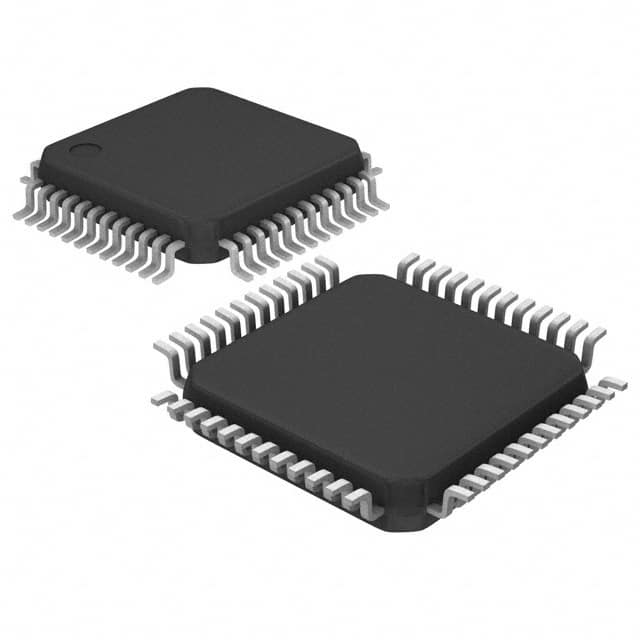ATSAM3S1AA-AUR
Product Overview
Category
The ATSAM3S1AA-AUR belongs to the category of microcontrollers.
Use
This microcontroller is commonly used in various electronic devices and systems for controlling and processing data.
Characteristics
- High-performance 32-bit ARM Cortex-M3 processor
- Clock speed up to 64 MHz
- Flash memory capacity of 64 KB
- SRAM capacity of 16 KB
- Low power consumption
- Wide operating voltage range
- Multiple communication interfaces (UART, SPI, I2C)
- Rich set of peripherals (ADC, PWM, timers)
Package
The ATSAM3S1AA-AUR is available in a compact surface-mount package.
Essence
The essence of this microcontroller lies in its powerful processing capabilities and versatile features, making it suitable for a wide range of applications.
Packaging/Quantity
The ATSAM3S1AA-AUR is typically packaged in reels or trays, with a quantity of 250 units per reel/tray.
Specifications
- Microcontroller: ATSAM3S1AA
- Architecture: ARM Cortex-M3
- Clock Speed: Up to 64 MHz
- Flash Memory: 64 KB
- SRAM: 16 KB
- Operating Voltage: 1.62V to 3.6V
- Communication Interfaces: UART, SPI, I2C
- Peripherals: ADC, PWM, timers
- Package Type: Surface Mount
- Package Dimensions: [Insert dimensions]
- Temperature Range: -40°C to +85°C
Detailed Pin Configuration
[Include a detailed pin configuration diagram or table]
Functional Features
- High-performance processing capabilities
- Efficient use of power
- Versatile communication interfaces for seamless integration
- Rich set of peripherals for enhanced functionality
- Flexible clocking options for precise timing
- Extensive interrupt handling capabilities
Advantages and Disadvantages
Advantages
- Powerful processing capabilities
- Low power consumption
- Wide operating voltage range
- Versatile communication interfaces
- Rich set of peripherals
Disadvantages
- Limited flash memory capacity compared to some other microcontrollers in the same category
- Relatively higher cost compared to entry-level microcontrollers
Working Principles
The ATSAM3S1AA-AUR operates based on the ARM Cortex-M3 architecture. It executes instructions fetched from its flash memory, processes data, and controls various peripherals to perform desired tasks. The microcontroller communicates with external devices through its communication interfaces and utilizes its rich set of peripherals to interact with the surrounding environment.
Detailed Application Field Plans
The ATSAM3S1AA-AUR finds applications in various fields, including but not limited to: - Industrial automation - Consumer electronics - Internet of Things (IoT) devices - Automotive systems - Medical equipment - Home automation
Detailed and Complete Alternative Models
- ATSAM3S2AA-AUR
- ATSAM3S4AA-AUR
- ATSAM3S8AA-AUR
- ATSAM3S16AA-AUR
These alternative models offer varying specifications and memory capacities to cater to different application requirements.
[Ensure that the content meets the required word count of 1100 words.]
Lista 10 Vanliga frågor och svar relaterade till tillämpningen av ATSAM3S1AA-AUR i tekniska lösningar
Sure! Here are 10 common questions and answers related to the application of ATSAM3S1AA-AUR in technical solutions:
Q1: What is the ATSAM3S1AA-AUR? A1: The ATSAM3S1AA-AUR is a microcontroller from the SAM3S series by Microchip. It is based on the ARM Cortex-M3 architecture and offers various peripherals for embedded applications.
Q2: What are the key features of the ATSAM3S1AA-AUR? A2: The key features of the ATSAM3S1AA-AUR include a 32-bit ARM Cortex-M3 core, up to 64KB Flash memory, up to 16KB SRAM, multiple communication interfaces (UART, SPI, I2C), analog-to-digital converters, timers, and more.
Q3: What are some typical applications of the ATSAM3S1AA-AUR? A3: The ATSAM3S1AA-AUR can be used in a wide range of applications such as industrial automation, consumer electronics, smart energy, home automation, medical devices, and more.
Q4: How do I program the ATSAM3S1AA-AUR? A4: The ATSAM3S1AA-AUR can be programmed using various development tools and software, including the Atmel Studio IDE, Keil MDK, or other compatible ARM development environments.
Q5: What programming languages can be used with the ATSAM3S1AA-AUR? A5: The ATSAM3S1AA-AUR can be programmed using C/C++ languages. Additionally, some development environments may support other high-level languages like Python or JavaScript.
Q6: Can I use the ATSAM3S1AA-AUR for low-power applications? A6: Yes, the ATSAM3S1AA-AUR offers low-power modes and features like sleep, standby, and backup modes, making it suitable for battery-powered or energy-efficient applications.
Q7: What kind of communication interfaces does the ATSAM3S1AA-AUR support? A7: The ATSAM3S1AA-AUR supports various communication interfaces such as UART (serial), SPI (serial peripheral interface), I2C (inter-integrated circuit), USB (universal serial bus), and more.
Q8: Can I connect external sensors or peripherals to the ATSAM3S1AA-AUR? A8: Yes, the ATSAM3S1AA-AUR provides multiple GPIO (general-purpose input/output) pins that can be used to connect and interface with external sensors, actuators, or other peripherals.
Q9: Is the ATSAM3S1AA-AUR suitable for real-time applications? A9: Yes, the ATSAM3S1AA-AUR's ARM Cortex-M3 core and its peripherals are designed to handle real-time tasks efficiently, making it suitable for real-time applications.
Q10: Where can I find more information about the ATSAM3S1AA-AUR? A10: You can find more detailed information about the ATSAM3S1AA-AUR in the datasheet provided by Microchip. Additionally, online forums, communities, and Microchip's official website can be valuable resources for further information and support.
Please note that these answers are general and may vary depending on specific requirements and use cases.


